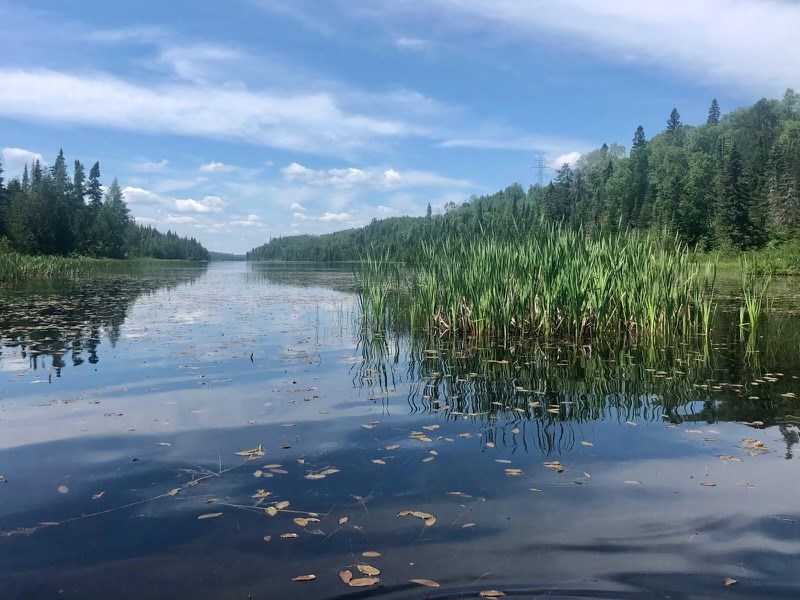THUNDER BAY — The Waasigan Transmission Line project is putting lake trout populations at risk, says a biotechnology PhD candidate at Lakehead University.
Brant Muir studies stormwater controls for protecting fish habitats. He said Upper Shebandowan Lake has been identified by the MNR under both the plan and the Crown Land Use Policy Atlas due to the presence of an at-risk lake trout population.
However, the MNR has granted Hydro One an exception of the Shebandowan Lake Management Plan.
“The (Ministry of Natural Resources) has previously taken a precautionary approach to the management of lake trout Lakes and this decision is definitely not following a precautionary approach,” said Muir.
He explained that the management plan has already identified existing transmission lines in the area as posing a threat to the cold-water ecosystem due to erosion problems that result in nutrient loads, which the plan was put into place to prevent and protect against.
“Lake trout are very sensitive to water quality changes, especially nutrient loads, and increased nutrient loads can reduce the dissolved oxygen concentrations, putting the spawning habitat and the coldwater ecosystem at risk,” said Muir.
“In Hydro One's environmental assessment, they've actually flagged this area as an ecologically sensitive area and despite recognizing it as such, they choose to proceed putting the project through this area anyways.”
The transmission line corridor is planned to be built directly adjacent to the shoreline and the wetland at the edge of Three Mile Bay.
“They have the option of reusing an existing transmission line corridor that was previously cut,” said Muir.
“This corridor is located directly north of the existing transmission lines, whereas Hydro One's preferred route is directly south of the transmission lines. So, to construct the line and avoid this ecologically sensitive area would only means shifting the line to approximately 100 metre north.”
The proposed road would also clear three hectares of forest and remove critical shoreline vegetation, which will increase erosion and phosphorus loading into the lake, according to Muir.
“One of the big things is we're not looking to stop the line. We know the line has to go through. We're looking for a simple solution of avoiding this ecologically sensitive area,” he said.
Muir said the further transmission line corridor would also allow for shoreline vegetation to be retained and having young alder and balsam as opposed to the mature forest a loss of less terrestrial wildlife habitat.
While the variance was received under the assumption that mitigation measures will prevent nutrient loads from entering the lake, he said Hydro One’s mitigation measures are not site-specific and they're very general and vague.
Muir has tried for almost three years to ask Hydro One to abide by the management plan’s restrictions and maintain waterside buffers suggested in the Thunder Bay District Land Use Guidelines by using the alternate corridor still following their preference to follow existing transmission lines.
However, he said Hydro One was very uncooperative to protect the area and were only willing to adjust the alignment for another part of the lake to mostly satisfy what he says are just “visual concerns.”
“They've already implemented three crossovers over the existing lines on a different area of the lake to reduce visual impacts and concerns for campers. We're just asking them to add one more tower to protect this ecologically sensitive area,” said Muir
When initially attempting to appeal through the management plan, the MNR offered little clarity and claimed they didn’t have the grounds to file the appeal as the project didn’t qualify as being ecologically significant, needing to be within in 30 metres of the lake and on private land, according to Muir.
An appeal with the Ontario Land Tribunal was also met with the response that they didn't have jurisdiction to rule over this issue. It was only afterwards that a MNR’s district manager, he said, reinserted that they do have an appeal mechanism under the management plan.
“An appeal to the Ministry of Natural Resources (MNR) may be exercised regarding the variance decision. The variance has been appealed and as that process is underway, MNR cannot provide further details,” wrote the MNR when asked about the project and appeal.
Overall, Muir feels the decision sets a precedent to open up for other industry to get similar variances on not just the lake, but any protected area in Ontario that's under MNR jurisdiction.
“It's such a terrible precedent for industry to bypass protected areas and existing legislation just because it's convenient to them, when there's an option available meets their preference and maintains protection for the environment,” said Muir.
